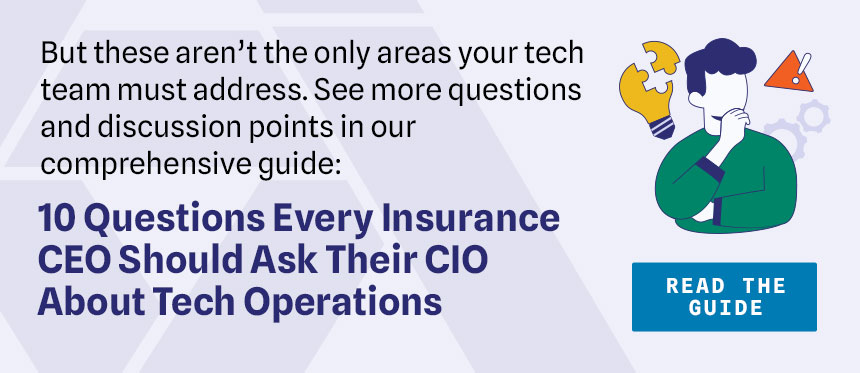Technology is changing everything these days, and CEOs and CIOs are facing some big decisions.
Any insurer hoping to succeed in this rapidly evolving industry needs a digital-first core system that can handle current challenges and is flexible enough to adapt smoothly to future developments.
Legacy and modern legacy core systems haven’t met those criteria for quite a while, but insurers can’t just jump into a core transformation without doing their due diligence. (Nor should they.)
The whole leadership team — particularly the CEO and CIO — should be on the same page, and there are some key questions to ask to get there.
Below are four discussion points to help establish a clear path forward for impactful, future-proof tech updates.
1. How Ready Are We to Make Changes?
If an insurer is seriously considering a core transformation, they’re aware at least some of their technology is behind the curve. But how much?
To get an idea, ask this question: How much of a barrier to progress are your existing core systems?
Beyond telling you “yes, we need to upgrade,” your CIO will be able to explain what about your core system needs to be different to make your desired progress.
Then, think of your core system like an aging building: Will a “facelift” solve your problems, meaning you can retain some systems or components, or do you need a “gut” — a complete overhaul? Or is it something in between?
Your CIO will be able to outline how easy (or difficult) it’d be to upgrade your core. For a “facelift” to work, the system you’re on should support continuous integration and deployment (CI/CD). If it doesn’t, and upgrading requires major effort from IT (with resources/budget to match), gutting the old core will be better in the long run.
2. What’s Your Team Working On to Improve the Customer Experience and Grow Revenue?
Tech updates that lower costs and boost operational efficiency are always a good thing. But they can’t be the only thing. CIOs must make room for customer experience improvements in any core transformation plan.
As just a few examples, this could mean creating more intuitive customer portals, adding intelligent automation to streamline claim intake, or improving customer data management for more personalized marketing. Updates like these hit the sweet spot of making things easier for customers while creating opportunities to generate revenue (through upsells, cross-sells, etc.) The CIO should look for a coretech solution that covers all those bases (and more).
3. What Can We Do To Get More Value From Our Data?
The importance of maximizing insurance data’s value in all possible ways can’t be overstated. For example, unfettered, real-time access to historical customer data helps adjusters make better decisions about complex claims. It also ensures policy admin teams don’t have to pore over old paper records to determine which rate factors should carry the most weight when pricing a policy.
Streamlining the flow of data needs to be at the forefront of any CIO’s mind when coretech upgrade conversations start.
CIOs should strive for 100% data fluidity — so it’s freely accessible whenever needed and accurate in real or near-real time. Cloud-native technology can make this happen across multiple channels, including mobile, while modern legacy systems can’t do this without complicated, resource-intensive integrations.
4. How Easily Can We Connect with Partners?
Because modern insurance customers expect more out of their carriers, being able to integrate with business and data partners is essential. Doing so with seamless integrations will allow you to:
- Broaden your product catalog (think specialized coverage, on-demand, or usage-based insurance)
- Expand your distribution (think digitally embedding policies at a business partner’s point of sale)
- Connect to key data sources (like public data sources to stay up-to-date on customers’ life changes)
Legacy core systems can’t support these partner integrations for the same reason they can’t enable true data fluidity: they don’t have API-first architectures that enable quick, “plug-and-play” integrations. Creating these connections requires coretech that uses open APIs, and that’s what CIOs must look for.
Ready to Plot a Course For Digital Transformation?
EIS Suite™ is the future-enabling core platform that can help your CIO answer all these questions effectively.
But these aren’t the only areas your tech team must address. See more questions and discussion points in our comprehensive guide: 10 Questions Every Insurance CEO Should Ask Their CIO About Tech Operations.





